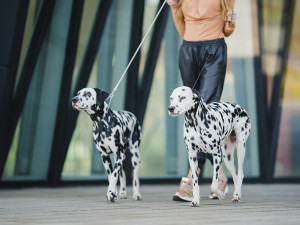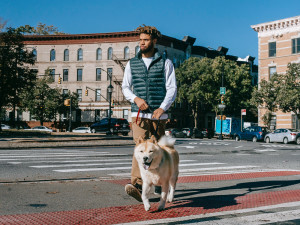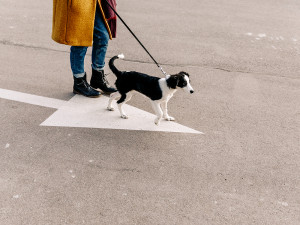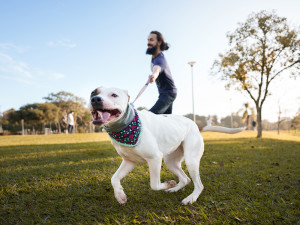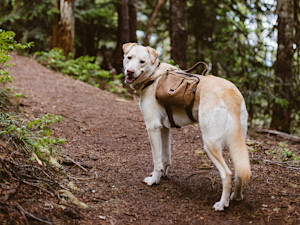Learn Leash Belay for Strong Pulling Dogs
This rock-climbing technique can take your dog-walking skills to the next level.
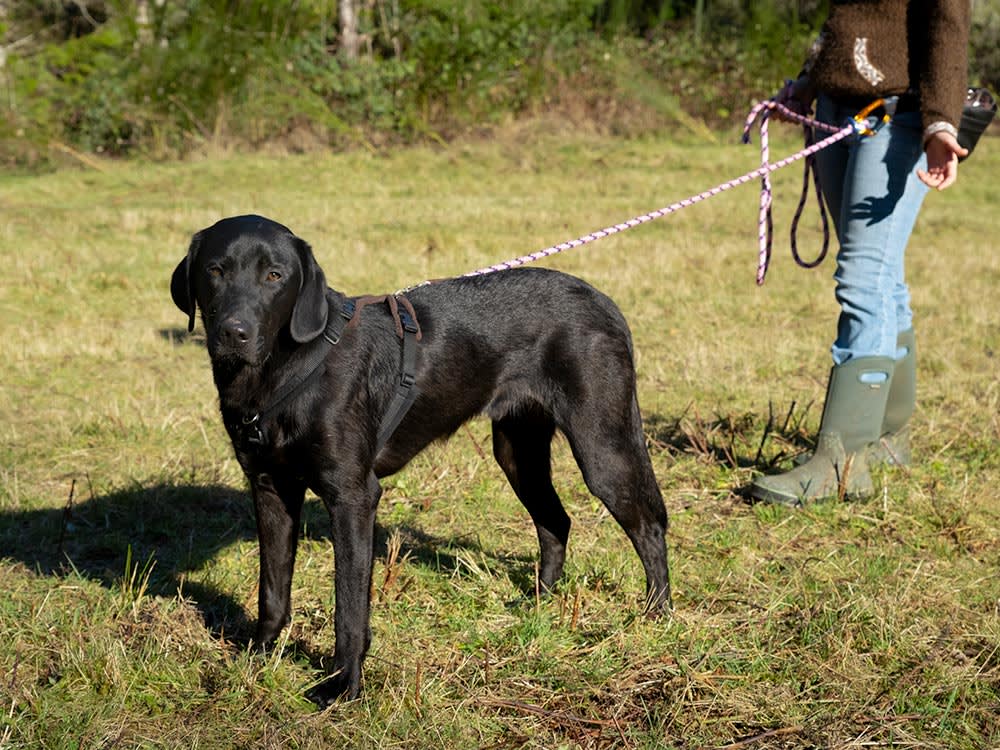
Share Article
It takes two to pull. When your dog pulls on their leash and barrels ahead, you’ll likely either run to catch up or pull back. If you try to catch up with your dog, that encourages them to keep pulling on the leash. And if you pull back on the leash, well, you’ll just be playing a game of tug of war. But there’s a better solution: leash belay.
What is Leash Belay?
Belaying, a rock-climbing technique that involves attaching a running line to the climber’s harness, can also be used to walk dogs. It’s gentle on the most excitable pups as well as on the hands that hold the leash.
Trainer Grisha Stewart is pioneering ways to apply those benefits in her already well-known Behavior Adjustment Training (BAT) approach. BATopens in new tab relies on positive reinforcement and leash skills to help anxious dogs feel more confident as they explore triggers. Teaching your dog to walk without pulling on the leash will require a lot of patience and practice, but it can be done.
Central to the new method is a small metal carabiner and an o-ring or two (or a similar climbing device). Instead of the leash sliding through your hands, it feeds through the o-ring, which absorbs the friction that causes rope burn. The basic moves for the handler are belaying—sliding the leash through the device—and braking with a smooth stop.

Benefits of Leash Belay
Belaying can boost leash-handling skills with a few simple pieces of equipment and lots of indoor practice in shortening and letting out the line. Unlike older, aversive leash training modes that use a leash pop to correct a dog’s sudden surge, belaying is a “least intrusive” approach, nudging the dog toward better behavior. Think slow stops and less jerking of the leash.
Good Tools to Get Started
Dynamic climbing rope (stretchier than standard rope leads… see below)
O ring(s)
Leash tab
Locking carabiner
Belts: Skijoring, CaniX
Super-strong belay devices: Beal birdie, ATC, figure 8 descender
Rope Leashes are a Must
Round leashes, which slide the most easily, pair best with the different devices. A 15-foot rope leash is used in BAT sessions, and to those familiar with BAT, tab belaying will feel most similar. A tab can be used with a shorter leash, but Stewart recommends that the leash be at least eight feet to allow enough braking time.
How Does Leash Belaying Work?
By testing her ideas with other trainers and different types of dogs, Stewart has come up with two belaying methods: belt and handle. In this videoopens in new tab, you will find full detailed instructions on how to use these two new methods to redirect a dog that pulls.
Belt Method
This is good for large dogs. The force of the dog’s pull is moved entirely off the handler’s arms, while hands are left free for other tasks. A carabiner can be hooked to a hip belt. To brake with the carabiner, the handler creates a V-shape with the lead.
Handle Method
A simpler version is the leash tab—basically, a handle with a clasp that attaches to a ring added to the leash. This keeps two handles—and hands—in play. The ring should be just big enough to slide easily. A second ring can be used as a brake, which you create by looping the leash handle through it (a tip suggested by leash designer Trisha Case of Trailblazing Tailsopens in new tab).
Working with Large or Reactive Dogs
What if you have a thrashing shark on the other end? No need to reel the dog in. Just shorten the line by walking up the leash, then reinforce heeling or another calm behavior, Stewart suggests. Offer treats or praise for slowing even a little. And aim to stay far enough from triggers to prevent reactivity in the first place.
Larger dogs who pull, especially those with whiplash-like reactions, can require maximum stopping power. This is where a hip belt and a heavy-duty belay device comes in. A regular belt (or even two collars hooked together) can be used, but a skijoring or CaniX belt is ideal, as they sit lower on the hips and stay put rather than ride up under your ribcage.
With a locking carabiner hooked to the belt, you can attach a super-strong belay device like a figure 8 descender or ATC to feed the line through more slowly. Pulling in your elbows will quickly stop the dog. The best, albeit the costliest, of these belay devices is a “beal birdie,” a climbing device with an autostop that does its job even if your hands are off the leash.
It all depends on you and your dog. Some will prefer the travel-light style found with the tab; others will embrace the protection of top-notch climbing gear. There are many ways to combine these tools and techniques, and new tweaks will surely be added now that climbing has gone to the dogs.
Tips on Using Leash Belay
Easing Your Dog to Slow
Lean back, locking the ring in place. To disengage, maneuver the line forward so the ring falls. Tying a knot in the leash will prevent the ring from hitting your hand. For strong pullers or jumpy types, a second ring is a good option, but Stewart advises watching a dog closely so you can engage the brake before the dog bolts. The line should be fed out far enough to allow extra time for stopping.
Guiding Direction Changes
When cueing the dog to change direction or stop, slide the leash hand-under-hand toward you. Slow stops, which are important for keeping dog and human in balance, are accomplished by squeezing down while letting out just enough line to brake gently.
Sheila Pell
Sheila Pell is a freelance journalist who frequently writes about environmental issues. Her work has appeared in The Washington Post, Modern Farmer, San Diego Reader, The Bark, and American Forests. She lives in northern California with her husband and two large dogs.
Related articles
![Person walking their dog in the street]()
How to Leash-Train a Puppy or Dog
Don’t let your new dog walk you.
![Afghan hound dog mid jump in an open grass field]()
Overexcited Dog? How to Calm A Dog Down
If your dog loses their sh*t over anything—from a squirrel to a guest. Here are some tips to curtail that.
![Man in park struggling to hold his Pitbull dog who is pulling on a leash]()
“How Do I Get My Dog to Stop Pulling on the Leash?”
Dog trainer Robert Haussmann’s tips for turning a stressful walk into a chill stroll.
![A happy lab wearing a backpack on a hiking trail.]()
Five Reasons My Dog Wears a Backpack
Wearing a backpack helped calm this reactive pup, and it could help yours too.
